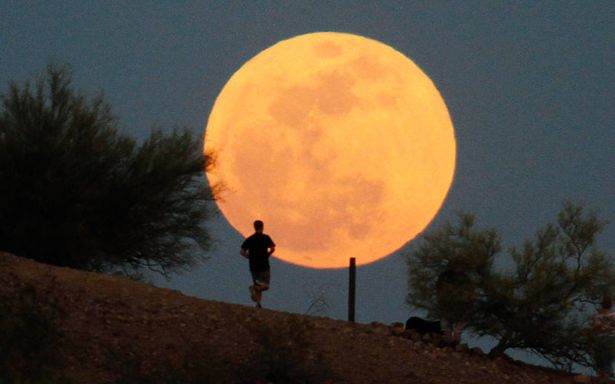At the end of the month, stargazers will be treated to another spectacular supermoon
January 2018 has been a good month for nighttime sky watchers.
The new year was brought in with a stunning supermoon on the night of January 1 – and we don’t have long to wait until the next one.
According to NASA – the next supermoon in 2018 will be on the night of January 31.
What’s more, because it’s the second full moon in the same calender month, it technically becomes a “blue moon” – an event that only happens every couple of years.

Supermoons are so-called because they appear larger and brighter in the sky than a regular full moon.
“The supermoons are a great opportunity for people to start looking at the Moon, not just that once but every chance they have,” said Noah Petro, a research scientist from NASA’s Goddard Space Flight Center.
When can I see it?
Look up on the nights of January 31 and even February 1 at about 2am (GMT) for the best view. There’s a window of opportunity if there are clear skies.
Make sure you’re as far away from light pollution as possible.
What is a supermoon?

A supermoon usually takes place every one to two years, when the full moon coincides with its closest point to Earth during its monthly orbit.
Because the moon has an elliptical orbit, one side – called the perigee – is about 48,280 km (30,000 miles) closer to Earth than the other side (the apogee).
When the sun, the moon, and Earth line up as the moon orbits Earth, that’s known as syzygy (definitely something you want to keep in your back pocket for your next Scrabble match).
When this Earth-Moon-Sun system occurs with the perigee side of the moon facing us, and the moon happens to be on the opposite side of Earth from the sun, we get what’s called a perigee-syzygy.
That causes the moon to appear much bigger and brighter in our sky than usual, and it’s referred to as a supermoon – or more technically, a perigee moon.
What is a blue moon?
It’s the rare moment when a second full moon appears during one calendar month, although its traditional meaning is slightly different.
A lunar month lasts about 29.5 days, whilst human months last anything between 28 and 31 days.
Occasionally, this means that a full moon can be seen twice in a month – which is referred to as a blue moon.
Is there anything special about the January 31 supermoon?

Yes, as well as being a supermoon, the January 31 moon will also enjoy a lunar eclipse.
“The moon’s orbit around our planet is tilted so it usually falls above or below the shadow of the Earth,” explained NASA.
“About twice each year, a full moon lines up perfectly with the Earth and sun such that Earth’s shadow totally blocks the sun’s light, which would normally reflect off the moon.”
As dedicated stargazers will tell you, this is the first time the UK has experienced a blue moon lunar eclipse in 150 years.
“The moon will lose its brightness and take on an eerie, fainter-than-normal glow from the scant sunlight that makes its way through Earth’s atmosphere,” the space agency said.
“Often cast in a reddish hue because of the way the atmosphere bends the light, totally eclipsed Moons are sometimes called ‘blood moons.’”
So it turns out that the next supermoon in 2018 will actually be a super-blue-blood-moon.
How to get the best picture?
- Stay away from bright lights
- Try and pick a spot marked by interesting buildings or trees so the moon shows up in comparison
- Keep the flash off
- If you’re using your phone use your finger to focus the camera on where the moon is
- The moon is actually moving so for a clear picture use an app that has a quick shutter speed
- Tripods, zoom lenses and all the extra bits aren’t really needed but will help keep you steady and get a better close-up












